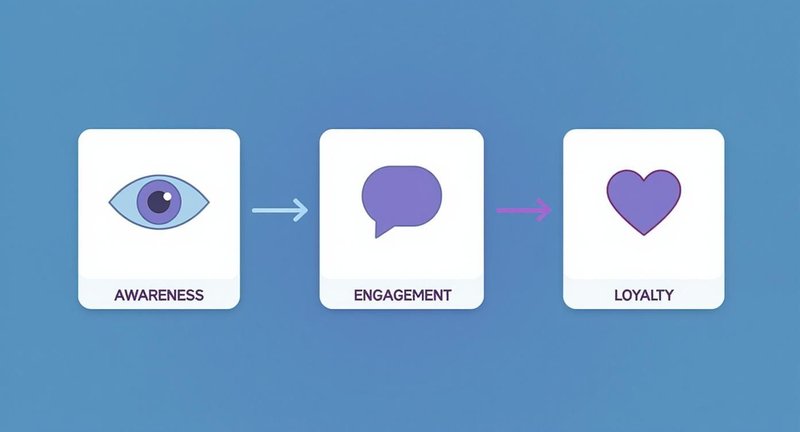
A Real Marketing Strategy for Small Business
Finally, a practical marketing strategy for small business owners in Australia. No jargon, just real-world advice to help you connect with customers and grow.
26 Oct 2025
Learn what is growth marketing with our practical guide to mindset, strategies, and experiments that drive real, sustainable business growth.
Blog
Growth marketing is a scientific approach to finding the most efficient ways to grow a business. It’s all about using rapid, data-driven experiments across the entire customer journey to figure out what truly makes your customers tick. Forget big, flashy campaigns; think continuous, clever testing.
Honestly, 'growth marketing' sounds a bit like corporate jargon. Something you'd hear in a boardroom and just nod along to, hoping no one asks you what it means.
But what if I told you it's less about buzzwords and more about being a detective for your business?
Imagine you’re trying to bake the perfect cake. The traditional marketing way is to follow a recipe you think is right, spend all day baking, and then just hope everyone loves it. You don't really know which ingredient made it great... or not so great. It's a bit of a gamble, really.
Growth marketing is like being a chef who tests everything. Constantly. You’d test a bit more sugar in one small batch. A different type of flour in another. You’d measure the results meticulously. You’d learn. It’s a process of constant, tiny improvements that lead to a spectacular result over time.
Instead of launching a big campaign and crossing your fingers (and we’ve all been there, that pit-in-your-stomach feeling), a growth marketer is obsessed with the 'why'. At its core, growth marketing is a practical form of data-driven marketing. It's about letting the numbers, not just your gut feeling, guide your decisions.
This isn't just theory; it’s a practical way to stop wasting your marketing budget. By focusing on small, measurable tests, you figure out what actually works before you pour serious money into it.
This means every single touchpoint with a customer is an opportunity for learning and growth. That includes:
Every single bit of the experience is on the table, ready to be tested and improved. It’s a huge shift from the old "set and forget" style of marketing.
And this isn't just some global trend; it's happening right here at home. The Aussie digital marketing scene is set to explode, projected to reach a massive $25.39 billion by 2034.
A huge driver of this is technology like AI, which makes the kind of personalised, data-led experiences central to growth marketing possible for businesses of all sizes. Now, more than ever, a solid strategy is crucial. If you're building out your approach, you can explore what a digital marketing strategy is and why you need one to get a stronger foundation.
This isn't just a fleeting trend... it’s the future of how smart businesses connect with customers.
Before we dive into the tools, tactics, or flashy funnels, we need to talk about the most important part. The mindset.
Honestly, this is the secret sauce. Growth marketing isn't some checklist you can download or a rigid process you just copy and paste. It’s a completely different way of thinking about how a business actually grows. It’s a culture, really.
It’s about being relentlessly curious. It's about treating every single assumption you have—every "we think our customers want this"—as just a question that needs a real, data-backed answer.
Have you ever launched a marketing campaign and just… crossed your fingers? You pour in all the work, you hit ‘publish’, and then you just hope people will click, buy, or sign up. We’ve all been there. It’s a gut-wrenching feeling, isn't it?
That's the old way. The growth mindset flips that on its head. Instead of making big, risky bets based on guesswork, you make small, calculated bets based on data.
Think of yourself less as a marketer and more as a scientist in a lab coat. You're not looking for one giant, explosive reaction. No. You're running dozens of tiny experiments, carefully observing the results, and learning something valuable each and every time.
Some tests will fail. A lot of them, probably. And that’s perfectly fine. In fact, it’s expected. A failed test is just as valuable as a successful one because it tells you what doesn't work, saving you time and money down the track.
The goal isn’t to be right all the time. The goal is to get less wrong over time by continuously testing, learning, and iterating your way towards real, sustainable growth.
This approach is so powerful because you don’t need a massive budget to get started. You just need to be clever and resourceful.
So, what does this actually look like day to day? It really boils down to three core principles that set growth marketing apart.
Adopting this mindset is the first and most crucial step in understanding what is growth marketing. It’s the foundation that every successful strategy is built on.
So, let's clear the air. Is growth marketing just a fancy, new-age name for digital marketing? You hear it thrown around and it's easy to think it's just the same old thing with a different label.
It’s not. It's a completely different beast.
Imagine traditional marketing is like producing a massive stage show. You spend months planning, you build incredible sets, you hire all the actors, and you have a huge opening night. Once the curtain falls... that's kind of it. The campaign is done.
Growth marketing, on the other hand, is like a never-ending improv comedy show. It's live, it's continuous, and you're constantly testing new jokes and reading the audience to see what lands. What makes them laugh. It never really stops; it just keeps getting better.
One of the biggest differences is where each approach focuses its energy. Think about it. Traditional marketing is often obsessed with the top of the funnel.
It's all about the big splash:
These things are all about getting attention. They do their job, and then their job is mostly done. The focus is almost entirely on grabbing new eyeballs. Which is fine, but it's only one part of the story.
A growth marketer, however, gets their hands dirty across the entire customer experience. They believe the real growth doesn't just come from getting a new customer but from turning that customer into a happy, long-term fan who tells their mates about you. It's an important distinction that separates it from just being about advertising. You can learn more about the differences between marketing vs advertising in our detailed guide.
This means they're just as focused on what happens after someone clicks 'buy'.
Growth marketing understands that your best new customers often come from your happiest existing customers. The journey doesn’t end at the sale; it begins there.
This obsession with the full journey, from the first hello right through to creating passionate advocates, is what really sets growth marketing apart.
Another way to look at it is the difference between projects and processes.
Traditional marketing often operates in defined campaigns. They have a clear beginning, a middle, and an end. The budget is set, the creative is approved, and the campaign runs for its allotted time. It's a series of distinct projects. Like little islands of activity.
Growth marketing is a continuous process of improvement. A marathon, not a series of sprints. It's built on a loop of hypothesising, testing, measuring, and learning. What worked last week? What didn't? How can we get a tiny bit better this week?
This constant cycle of experimentation means a growth marketer is always looking for small wins that compound over time. They aren’t looking for a single silver bullet; they're building a growth engine, piece by piece. It’s the difference between trying to catch lightning in a bottle and building a sustainable power plant.
Alright, let's get a little bit nerdy—but in a super useful way. We're going to talk about a framework called the Pirate Funnel.
Yes, I know. The name is a bit silly. It comes from its acronym, AARRR... like a pirate. But trust me on this, once you get past the name, it’s a total game-changer for really understanding your customers.
This isn’t just another business model diagram you'll forget about. Think of it as a treasure map for your customer's entire experience with your business, from the first time they hear about you to the moment they're telling their friends to check you out. It gives you a clear lens to see exactly where your marketing is working and, more importantly, where it might be falling flat.
This simple infographic below outlines the a typical customer journey from first glance to becoming a loyal fan.

It shows that growth marketing is a continuous process of moving customers from initial awareness all the way through to genuine loyalty.
The funnel is broken down into five distinct stages that every customer moves through. Let’s walk through them one by one, with some simple, real-world examples.
The real power of the Pirate Funnel is that it helps you diagnose problems.
Are you getting heaps of traffic (Acquisition) but very few people are signing up (Activation)? Then you probably have a problem with your website's messaging or user experience.
Are people signing up but never coming back (Retention)? Maybe your onboarding process isn't clear enough, or the product itself isn't delivering on its promise. For marketers navigating the customer journey and optimising stages like Activation and Retention, this step-by-step guide to automating customer onboarding can be invaluable.
By looking at your business through this AARRR lens, you stop guessing and start seeing exactly where you need to focus your energy. It helps you ask the right questions and pinpoint the leaks in your customer journey.
This framework transforms what is growth marketing from a vague concept into a clear, actionable plan. It gives you a map to follow, ensuring you're not just throwing things at the wall and hoping they stick.

Alright, the theory is great, but let's get our hands dirty. How do you actually do this stuff? It can feel a bit overwhelming, like you need a data science degree just to get started.
You don't. I promise.
The real heart of growth marketing isn’t some complex algorithm; it’s about running small, smart experiments. It’s about taking that first, crucial step from thinking to doing. You don't need a massive budget or a fancy analytics setup to begin. The goal here is to show you that experimentation isn't scary... it's just about making an educated guess and then letting your customers tell you if you're right.
The key is to begin with a simple, testable question. You’re not trying to double your revenue overnight. Not yet anyway. You’re just trying to get a 1% improvement.
Think of your business as a big machine with lots of little levers. Your first experiment is simply pulling one of those levers slightly to see what happens. No big deal.
So, where do you find that first lever to pull? Here are a few classic places to start:
These might sound tiny. Insignificant, even. But this is where the magic happens. Small, consistent wins add up to massive growth over time. It’s the compounding interest of marketing.
An experiment is just a conversation with your customers. You make a small change, and their behaviour—clicks, sign-ups, purchases—is their reply. You just have to listen.
Ready to run your first test? Don't overcomplicate it. Just follow these simple steps.
This isn’t just for websites, either. You can test ad creative, social media posts, or email campaigns. The rapid growth in the Australian online advertising market, which hit AUD 17.2 billion recently, shows just how many opportunities there are to test and optimise on digital platforms. You can find out more about these trends in this IAB Australia report on online ad spend.
The most important part is just to start. Pick one small thing. Run one small test. See what happens. You've got this.
Okay, so your head is probably buzzing with ideas and questions right now. That's completely normal. When you first start digging into growth marketing, a bunch of "but what about..." thoughts pop up. It can feel like a big, complicated world.
Let's tackle some of the most common questions people have when they're first dipping their toes in. Think of this as a friendly chat to clear up a few of those lingering doubts—the kind of thoughts that bubble up as you try to figure out if this is the right path for your business.
That's a super common myth, and it’s one we need to bust right away.
While growth marketing definitely got its start in the fast-paced, move-or-die world of Silicon Valley startups, its principles are absolutely universal. At its heart, it's all about understanding your customers deeply and using data to make better decisions. That’s it.
This applies whether you're selling software, running a local cafe in Melbourne, or offering a professional service in Sydney. Any business that wants to grow in a smart, sustainable way can use these ideas. The tools might look different, sure. A cafe might experiment with its loyalty program, while a tech company tests its app's onboarding flow. But the core mindset of testing and learning is exactly the same. It's for everyone.
This is a great question because it's a huge mental hurdle that holds a lot of people back. You don't need 'big data' to begin. Honestly.
You can start with what you already have. Have you got Google Analytics on your website? That's a goldmine of information just waiting for you. Do you have an email list? You can look at open rates and click-through rates right now.
Even simple customer feedback from emails or conversations is a form of data. It’s qualitative, but it’s incredibly valuable.
The key is to start small and not let the perfect be the enemy of the good. Don't wait for the perfect dataset; start with what you've got. Your first experiments might be based on a hunch from a customer email, and that's totally fine.
As your business grows, the data you collect will become richer and more detailed. Then, your experiments can become more sophisticated. But the starting point is wherever you are today.
This one causes a lot of confusion, but there’s a simple way to think about it.
Think of it like this: a digital marketer is often a specialist, and a growth marketer is a strategist who uses those specialities. A brilliant digital marketer might be an absolute expert in SEO or social media ads. They know their channel inside and out.
A growth marketer, on the other hand, looks at the entire business and asks, "Where is our biggest opportunity for growth right now?" That opportunity might be in SEO, but it could just as easily be in improving the product itself to keep customers around longer (retention), or in creating a killer referral program.
The growth marketer’s job is to use data to find that single leverage point—the one thing that could have the biggest impact—and then pull in the right specialists to run the experiment. Their focus is much broader, spanning marketing, product, sales, and even customer service. They connect all the dots.
Ah, the million-dollar question. This is where you get the "it depends" answer that nobody loves, but it's the most honest one.
Growth marketing isn't a magic bullet or an overnight fix. Some of your experiments will deliver quick, exciting wins. You might change a button colour on your website and see a 10% lift in clicks within a week. That's fantastic, and those wins feel great. They prove the process works.
But the real, game-changing growth—the kind that transforms a business—comes from the compounding effect of hundreds of small wins over time. It’s about building a 'growth engine' that is constantly learning, adapting, and improving, week after week.
So while you might see some positive signals early on, which is incredibly motivating, true, sustainable growth is a long-term commitment. It's a marathon, not a sprint. But it's a marathon where every step forward makes the next one a little bit easier.
Feeling like you need the right marketing talent to start building your own growth engine? Cemoh connects you with the top 1% of pre-vetted marketing experts in Australia, from fractional CMOs to specialist freelancers. Find the perfect fit for your business in just 48 hours and start growing smarter, not harder.
Find your expert marketer at https://cemoh.com
Here are some suggested articles that are closely related to this post

Finally, a practical marketing strategy for small business owners in Australia. No jargon, just real-world advice to help you connect with customers and grow.

Build a small business marketing strategy that works. This guide offers practical, no-nonsense tips for real results, designed for Australian business owners.

Need a marketing consultant for small business? Discover expert tips and guidance to boost your small business marketing success today.

Explore how a fractional CMO Australia can elevate your marketing strategy, reduce costs, and drive growth for your business. Find out more now!

Feeling lost in the Australian job market? This guide has real, practical steps on how to get a job, from fixing your resume to nailing the interview.

Feeling stuck? Discover practical, low-cost small business marketing ideas you can use today. Real examples for Australian businesses.